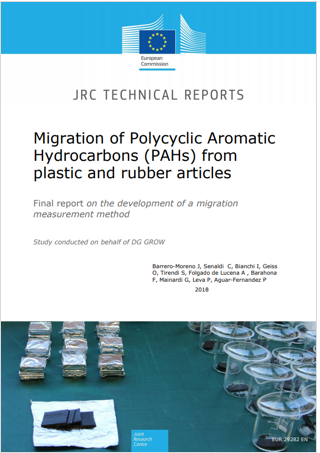Migrazione IPA da articoli in plastica e gomma
| ID 6644 | | Visite: 6552 | Documenti Riservati Chemicals | Permalink: https://www.certifico.com/id/6644 |
Migrazione di idrocarburi policiclici aromatici (IPA) da articoli in plastica e gomma
JRC 2018
Rapporto finale sullo sviluppo di un metodo di misurazione della migrazione - Studio
Gli idrocarburi policiclici aromatici (IPA) costituiscono un ampio gruppo di sostanze chimicamente correlate, molte delle quali sono cancerogene note. Per ridurre al minimo l'esposizione umana esistono già numerosi atti legislativi dell'UE che limitano la loro presenza in determinati prodotti alimentari, nonché nell'acqua e nell'aria ambiente. Ai sensi del regolamento REACH (CE 1907/2006, allegato XVII, voce 50), otto IPH prioritari sono stati da tempo limitati negli oli diluenti usati nei pneumatici.
Sebbene non aggiunti deliberatamente ai prodotti di consumo, gli IPA possono ancora essere presenti come impurità.
Una modifica della suddetta legislazione (Regolamento UE 1272/2013) stabilisce limiti di contenuto per gli otto IPA di 0,5 mg kg-1 per componenti in plastica e in gomma di giocattoli / articoli per l'infanzia e 1 mg kg-1 per tutti gli altri articoli di consumo, in diretto e prolungato o in corto -termine ripetitivo, contatto con la pelle o la cavità orale. Nel maggio 2016 la DG JRC e la DG GROW hanno firmato un accordo amministrativo (AA 34003) noto come progetto STANPAHs.
L'obiettivo principale del presente contratto era che il CCR fornisse supporto scientifico all'attuazione e alla potenziale modifica della restrizione relativa agli idrocarburi policiclici aromatici, in particolare per quanto riguarda i paragrafi 5 e 6 della voce 50 dell'allegato XVII della legislazione REACH.
Gli obiettivi principali del progetto erano:
b) sviluppare una metodologia affidabile per determinare la migrazione di PAH da queste matrici, in condizioni che simulino, nella migliore misura possibile, il contatto dermico (compresa la cavità orale).
Questo rapporto presenta i risultati degli studi sperimentali condotti presso il CCR e i risultati conseguiti nel raggiungimento di questi obiettivi.
_________
Contents
Acknowledgements
Abstract
1. Introduction
1.1 Scoping study and literature review. Short summary
2. Experimental design
2.1 Selection of reference materials
2.1.1 Plastic ad-hoc manufactured
2.1.2 Rubber ad-hoc manufactured and raw materials
2.1.3 Recycled rubber granules
2.1.4 Commercial products
2.1.5 Extender oils from industries
2.2 Development of a method for the total content determination of EU-PAHs in plastic and rubber materials
2.2.1 Activities undertaken towards the development of an improved methodology for the determination of the 8EU-PAHs in rubber and plastic materials
2.2.1.1 Extraction
2.2.1.2 Clean-up/purification
2.2.2 Total content analysis of ad-hoc manufactured materials, raw-materials and consumer articles purchased on the retail market
2.3 Selection of simulants for the Development of a method for the evaluation of the release of EU-PAHs from plastic and rubber materials
2.3.1 Aqueous biofluid simulants
2.3.2 Modified sweat simulant formulation
2.3.3 Alternative approaches
2.4 Development of a method for the evaluation of the release of EU-PAHs from plastic and rubber materials
2.4.1 Working procedure applied to migration in aqueous biofluid. Preliminary tests with aqueous sweat EN1811 and aqueous saliva DIN 53161-1
2.4.2 20% aqueous Ethanol. Set-up of migration step and in-house validation of protocol
2.4.3 Aqueous sweat modification: artificial Skin Surface Film Liquid (SSFL)
2.4.4 Migration of EU-PAHs from NR BR onto sebum imbued filter paper strips
3. Results and discussion
3.1 Evaluation of the total content of EU-PAHs from plastic and rubber materials
3.1.1 Extraction
3.1.1.1 Randall hot extraction compared to ultrasound extraction
3.1.1.2 Completeness of extraction
3.1.1.3 Estimation of trueness
3.1.2 Purification
3.1.2.1 Recovery experiments of SupelMIPTM SPE cartridges
3.2 Total content analysis of ad-hoc manufactured materials, raw-materials and consumer articles purchased on the retail market
3.2.1 Total EU-PAH content in ad-hoc manufactured test materials and raw materials
3.2.2 Total EU-PAH content in consumer articles purchased on the retail market
3.3 Evaluation of the release of EU-PAHs from plastic and rubber materials
3.3.1 20% aqueous Ethanol
3.3.2 Skin Surface Film Liquid
3.3.3 Sebum imbued filter paper strips
4. Inter-laboratory study on the migration of EU-PAHs from plastic and rubber materials into 20% aqueous Ethanol
4.1 Test materials and sample preparation
4.2 Homogeneity assessment
4.3 Sample distribution
4.4 Results of collaborative trial
5. Conclusions
References
List of abbreviations and definitions
List of Figures
List of Tables
Annex 1 STANPAHs: Migration of PAHs from plastic and rubber materials intended for the general public - Experimental Design
Annex 2 Standard Operating Procedures for the total content determination of EUPAHs in plastic and rubber materials
Annex 3 Standard Operating Procedures for the determination of migration of EUPAHs
from rubber and plastic materials into 20% aqueous Ethanol
Annex 4 Migration test protocol using artificial skin surface film liquid (SSFL) as
migration medium
Annex 5 Migration Test Protocol using Sebum Imbued Strips as Migration Medium
Annex 6 Initial Collaborative Trial
...
Fonte: Commissione Europea
Collegati:
| Descrizione | Livello | Dimensione | Downloads | |
|---|---|---|---|---|
| Migration of Polycyclic Aromatic Hydrocarbons from plastic.pdf |
6801 kB | 10 |
Tags: Chemicals Reach Abbonati Chemicals
